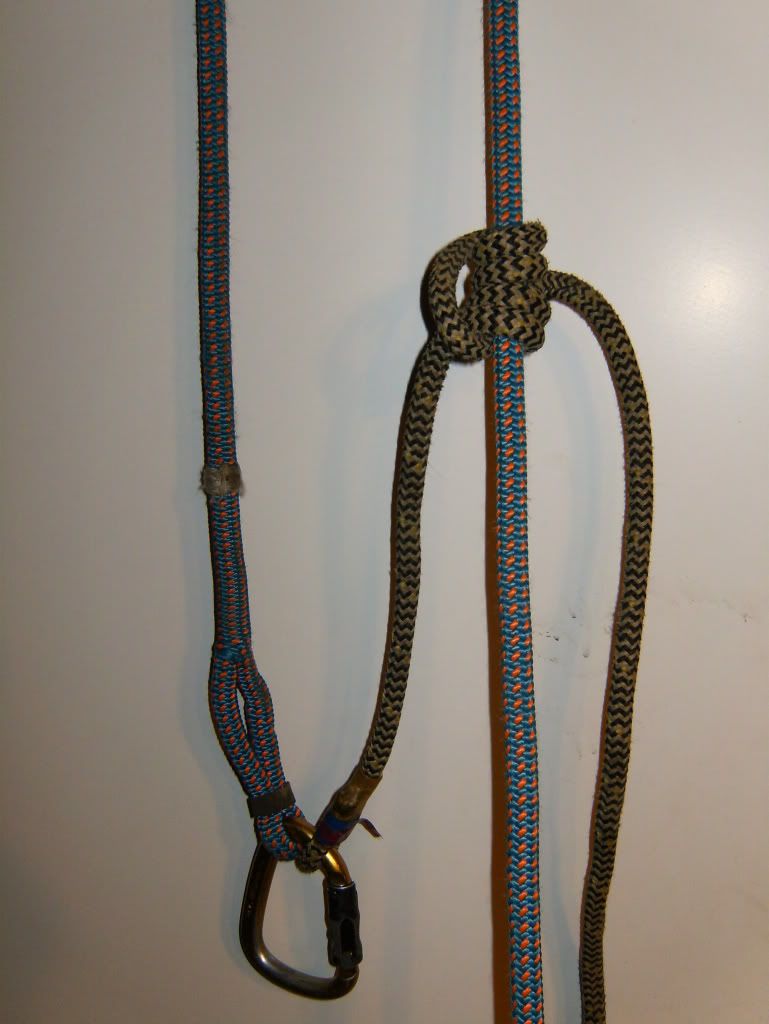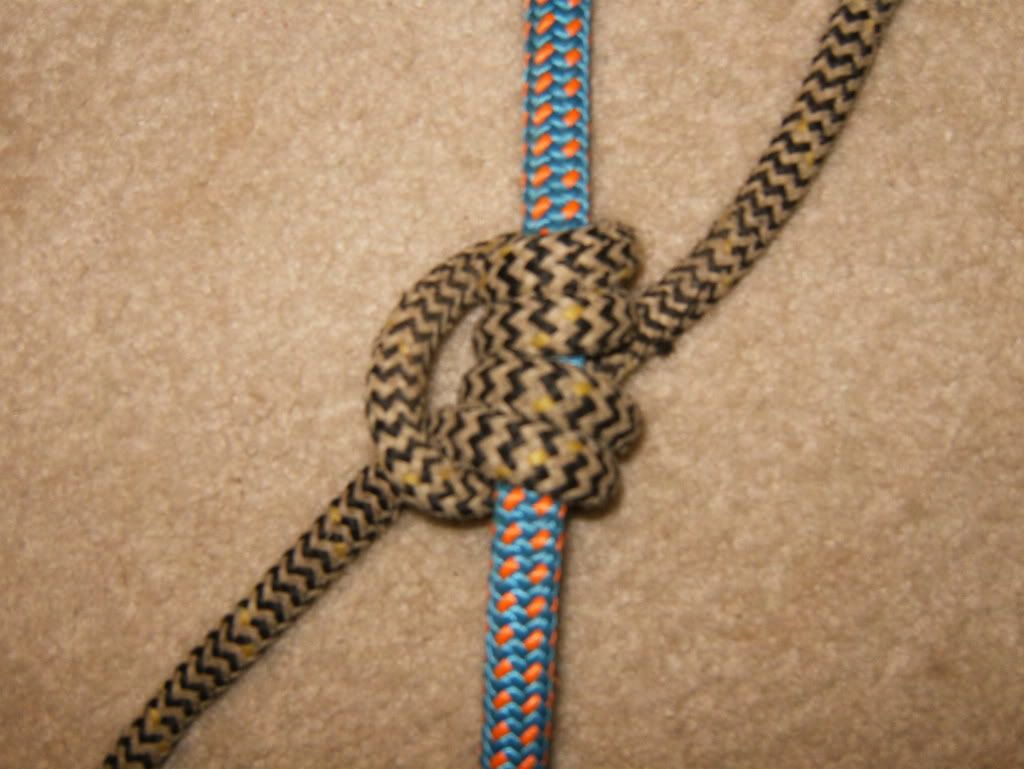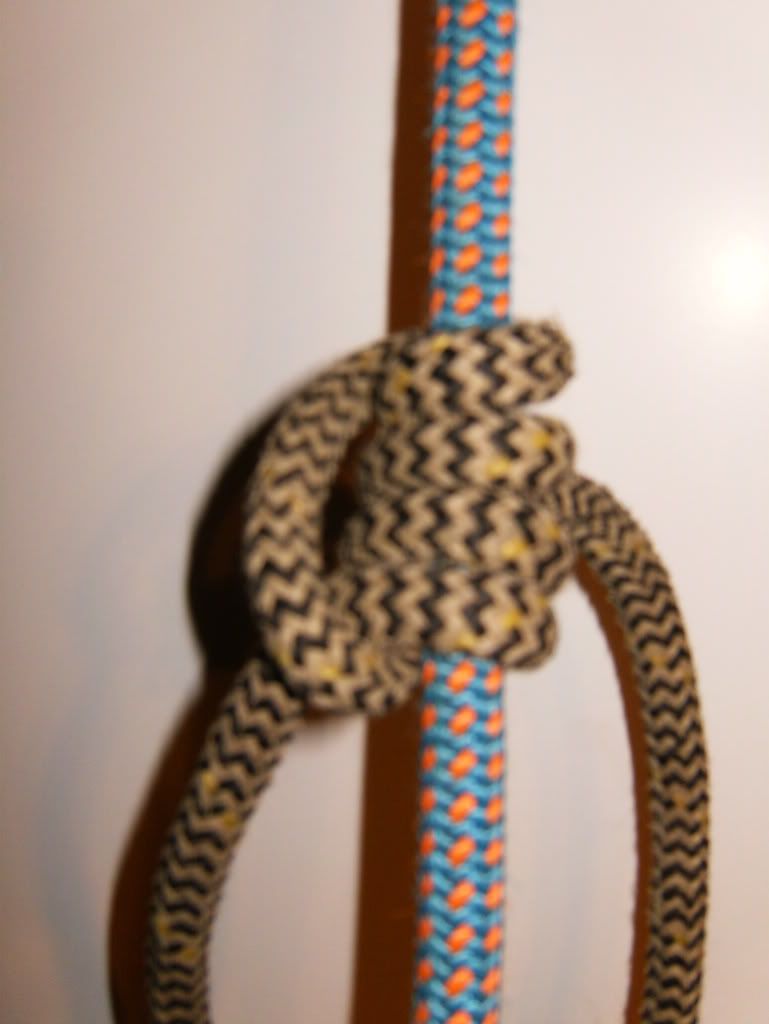You are using an out of date browser. It may not display this or other websites correctly.
You should upgrade or use an alternative browser.
You should upgrade or use an alternative browser.
Blake's Hitch
- Thread starter Buzzkill
- Start date

Help Support Arborist Forum:
This site may earn a commission from merchant affiliate
links, including eBay, Amazon, and others.
Iustinian
ArboristSite Operative
ANSI says it has to be smaller
ANSI says the friction hitch needs to be tied with a rope that is 3mm smaller than the climbing line. it'll grab faster/harder and be safer. what line are you climbing on?
ANSI says the friction hitch needs to be tied with a rope that is 3mm smaller than the climbing line. it'll grab faster/harder and be safer. what line are you climbing on?
1/2" climbing rope and a 5/16" diameter 30" long prusik. I'm just starting and this all came in a climbing kit. I'm practicing on an old swing set till i am 100% confident i can string my thick-self in a tree and come down safely. I tie the knot, dress it, and tighten it standing. then lean back into it and then hang and the knot itself binds real hard. hanging off the top of the knot with both hands puttin all my weight on it wont get it to move. I must be tying it wrong. 2 loops over and 2 under is what im doing.
RacerX
Addicted to ArboristSite
Funny that there's an recommendation that the friction hitch be 3mm smaller than the climbing line because when you're using a Blake's hitch your hitch is tied with a rope the same size as the climbing line. :msp_rolleyes:
I use a 10mm beeline on a 11.5mm rope. I prefer the 10mm over a 5/16" since it's larger and easier to work with when wearing gloves.
I use a 10mm beeline on a 11.5mm rope. I prefer the 10mm over a 5/16" since it's larger and easier to work with when wearing gloves.
thepheniox
ArboristSite Operative
A prusik is an endless loop. I think you have a 30 inch spliced eye. Also sounds like your tying a tautline and not a blakes hitch. Maybe post a photo if you can. Would help.
Iustinian
ArboristSite Operative
Funny that there's an recommendation that the friction hitch be 3mm smaller than the climbing line because when you're using a Blake's hitch your hitch is tied with a rope the same size as the climbing line. :msp_rolleyes:
I use a 10mm beeline on a 11.5mm rope. I prefer the 10mm over a 5/16" since it's larger and easier to work with when wearing gloves.
you can use a blake's hitch with a split tail 3mm smaller -- heres a few pics of a blake's tied with 8mm beeline on Lava (11.5mm)



I can find a step-by-step instructions link for you or take some step-by-step pictures if one of you needs it, but personally, I recommend getting an eye-to-eye friction cord and learning to tie and climb on the distel, valdotain tresse, michocain or knut

$79.99
$89.99
ZELARMAN Chainsaw Chaps 8-layer Protective Apron Wrap Adjustable Chainsaw Pants/Chap for Loggers Forest Workers Class A
QUALITY GARDEN & HAND TOOLS

$15.95 ($15.95 / Count)
$17.99 ($17.99 / Count)
Fiskars Pole Saw Blade Replacement for Fiskars Pruning Saws and Tree Pruners, 15 Inch Saw Blade with Woodzig Chainsaw-Style Saw Tooth Design
OKB85

$142.39
$179.99
ROPE Logic Ultra Ring Sling #3 Riggling Thimble 3/4" Tenex x 6' (40203)
Greener-Garden

$215.05
$233.19
Weaver Leather WLC 315 Saddle with 1" Heavy Duty Coated Webbing Leg Straps, Medium, Brown/Red
Amazon.com

$35.99
$39.99
Wood Kindling Splitter - The Firewood Kindling Tool for Wood Stove Fireplace and Fire Pit
UniExtra

$19.99 ($3.33 / Count)
Firewood Log Splitter 45mm+32mm + 4 Handles (Square + Round + Hex Shank + Small Hex) Wood Log Splitter Easy Splitter Detachable Drill Bit Heavy Duty Electric Drills Screw Cone Driver Removable
JianShiMoQinDianZiShangWuYouXianGongSi
freeweight
ArboristSite Operative
beeline isnt the greatest choice for an open system....i used 10mm on 13mm nothing i did could get that hitch to move (4/2 blakes)
i then switched to blaze for the hitch and even then it was a bit rough but after breaking in it worked perfect ,now i use a 6/2-3 blakes just to make the hitch a lil bigger for my hand
i then switched to blaze for the hitch and even then it was a bit rough but after breaking in it worked perfect ,now i use a 6/2-3 blakes just to make the hitch a lil bigger for my hand
Iustinian
ArboristSite Operative
beeline isnt the greatest choice for an open system....i used 10mm on 13mm nothing i did could get that hitch to move (4/2 blakes)
yea, I remember those days lol. either locking off with the feet or reaching above the knot to take the weight off it, and then sliding it open a little with my thumb.
But that is why it didn't take me long to switch to eye-to-eye knots.
but the beeline blake's will grab reliably when you need it to.
VA-Climber
ArboristSite Lurker
If you already have what seems to sound like a spliced eye prusik cord, you should invest a little time and energy in studying the french prusik/VT knot. When I first started, I can remeber wrestling a seizing friction hitch (blakes) all the way out of the tree and saying to myself "Who said descending is fun? This sucks!". Once you understand the details to the french prusik you can tie it a couple different ways to suit your climbing needs (grab power, ease of release, different climber weight). Depending on what line you climb on, this hitch will actually tend slack all by itself due to the weight of your dangling climb line, but only after about 35-40ft. This knot releases incredibly easy with no 'massaging' or lengthening of the bridge, grabs quickly and securely and spreads the climbers weight over a greater surface area of the climb line. The particulars of this knot require much attention to detail, and if not tied exactly right can result in an uncontrolled fall (just like all knots). I climb on 1/2" Samson ArborMaster and use 3/8" Ultratech prusik cord (10,000lb). As a rule of thumb, the prusik cord used in this setup should be 25% smaller than your climb line. This combination and setup works very well for both spur climbing and rope climbing (spurless trim jobs) and my brother and I have both used it for quite some time now with no complaints, although he ties his different due to a 15 pound weight difference. Study, experiment, and play with this knot and you will not regret you spent the time and effort to do so. You are wise for doing your learning while hanging from a swingset... as foolish as it may look, there's not much of a chance of accidents happening there. Slow is smooth, smooth is fast. Take it low and slow and above all, be safe.
Last edited:
tree md
Addicted to ArboristSite
A prusik is an endless loop. I think you have a 30 inch spliced eye. Also sounds like your tying a tautline and not a blakes hitch. Maybe post a photo if you can. Would help.
Wrong. A prussic is a type of friction hitch. It can be tied with an endless loop, with a prussic cord or with the end of your climbing line.
When I climbed on a traditional, closed system I used a plain old prussic tied on the end of my line. It ran much smoother than a Blakes hitch. There are much more sophisticated knots you can use but I would stick to something simple until you get a little experience under your belt. I like the VT but if you do not give it your utmost attention it can invert on you causing it to not bite and sending you to the ground in a hurry.
Last edited:
deevo
Addicted to ArboristSite
you can use a blake's hitch with a split tail 3mm smaller -- heres a few pics of a blake's tied with 8mm beeline on Lava (11.5mm)



That's what I use as well, also remember your figure 8 stopper knot!
ANSI says the friction hitch needs to be tied with a rope that is 3mm smaller than the climbing line. it'll grab faster/harder and be safer. what line are you climbing on?
You wouldn't have a quote on that would you? I don't think that is correct.
THOUSANDS of old school climbers are using no split tail at all, and the friction hitch is tied with the same rope that the climber is hanging from.
tree md
Addicted to ArboristSite
I think he is trying to say no smaller than 3 MM David. That is how I understood the standard to read. But it's been a long time since I have read it.
You wouldn't have a quote on that would you? I don't think that is correct.
THOUSANDS of old school climbers are using no split tail at all, and the friction hitch is tied with the same rope that the climber is hanging from.
Seems to me if you are gonna try a blakes hitch, this is the easiest way to do it. It's all I ever use.
As for the figure 8 on the end of the tail, a smart thing to do in the beginning stages, but I've never seen a true need for it, the tail just never slips.
tree md
Addicted to ArboristSite
Seems to me if you are gonna try a blakes hitch, this is the easiest way to do it. It's all I ever use.
As for the figure 8 on the end of the tail, a smart thing to do in the beginning stages, but I've never seen a true need for it, the tail just never slips.
The stopper knot is not just a beginners precaution, it's mandatory. It only takes one time for the end to slip through and you are a goner.
And we're not talking about the tail of the rope, we are talking about the running end where your friction hitch terminates.
VA-Sawyer
Addicted to ArboristSite
I agree on the stopper knot being required for the tail of a tautline and recommended for a Blakes as well.
I also say a safety stop is required on the tail of the climbing line if there is a chance of the climber exceedind 1/2 of the rope length including redirects.
As for the 3mm rule, I couldn't find it in my 2006 z133. Does someone have a ref number ?
Rick
I also say a safety stop is required on the tail of the climbing line if there is a chance of the climber exceedind 1/2 of the rope length including redirects.
As for the 3mm rule, I couldn't find it in my 2006 z133. Does someone have a ref number ?
Rick
Iustinian
ArboristSite Operative
I think it was in the updates.
I have a copy of it saved somewhere, trying to consolidate and organize lol. As I recall, the minimum mbs of climbing linesand all supporting hardware in work positioning systems is 5k lbs, or 22.2kN; the minimum thickness of climbing lines is 11mm, and the update calls for the friction cord to be 3mm less than the climbing line. That is, if you are climbing on a 1/2 inch rope (13mm), then you would need to be using a 10mm friction cord. For climbing on a 11mm line, you would need 8mm friction cord.
ANSI constantly changes, and gets updated often. I remember finding the info in one of the latest updates, but I'll try to dig it up as time allows.
I have a copy of it saved somewhere, trying to consolidate and organize lol. As I recall, the minimum mbs of climbing linesand all supporting hardware in work positioning systems is 5k lbs, or 22.2kN; the minimum thickness of climbing lines is 11mm, and the update calls for the friction cord to be 3mm less than the climbing line. That is, if you are climbing on a 1/2 inch rope (13mm), then you would need to be using a 10mm friction cord. For climbing on a 11mm line, you would need 8mm friction cord.
ANSI constantly changes, and gets updated often. I remember finding the info in one of the latest updates, but I'll try to dig it up as time allows.
Ax-man
Addicted to ArboristSite
Wrong. A prussic is a type of friction hitch. It can be tied with an endless loop, with a prussic cord or with the end of your climbing line.
When I climbed on a traditional, closed system I used a plain old prussic tied on the end of my line. It ran much smoother than a Blakes hitch. There are much more sophisticated knots you can use but I would stick to something simple until you get a little experience under your belt. I like the VT but if you do not give it your utmost attention it can invert on you causing it to not bite and sending you to the ground in a hurry.
Your right, but what you are referring to is called an open prussic. I agree with you , an open prussic was a much better climbing hitch than a Blakes or the Tautline.
To the OP, you are definately doing something wrong . A Blakes will lock up from time to time but it still should move . If your using a smaller cord for a split tail then I would say this is your problem. A Blakes,Tautline ,open prussic are basically constrictor type knots that bind to the parent rope, a smaller cord will make them bite down harder on the parent rope. Those smaller cords are basically for VT hitches.
Last edited:
formationrx
ArboristSite Guru
call me crazy
my new guys are always taught the taut line first ( 3 under and 1 over)-- using a single 5/8 true blue or 1/2 blue streak life line. when they can use that efficiently... and understand the way the knot works... then they can use any other knot they want.
my new guys are always taught the taut line first ( 3 under and 1 over)-- using a single 5/8 true blue or 1/2 blue streak life line. when they can use that efficiently... and understand the way the knot works... then they can use any other knot they want.
















































